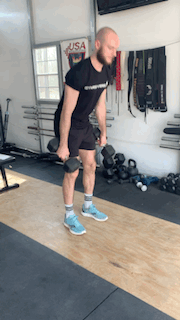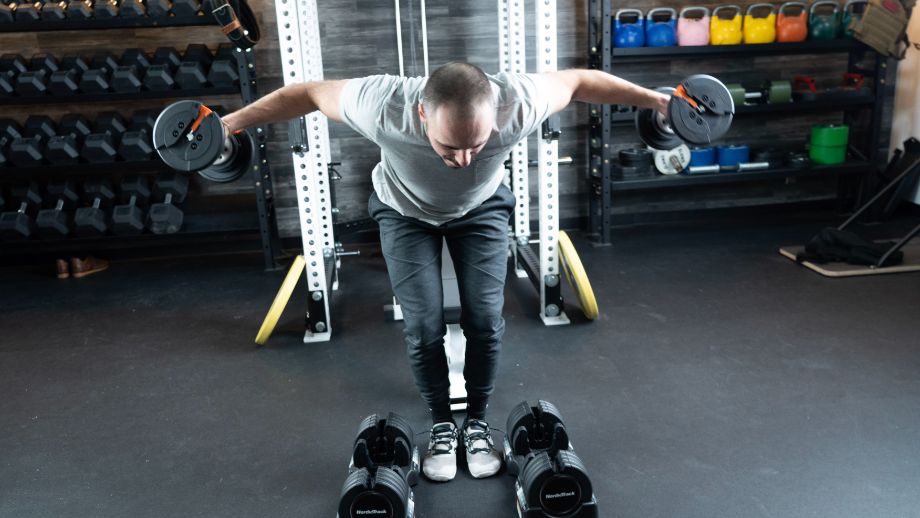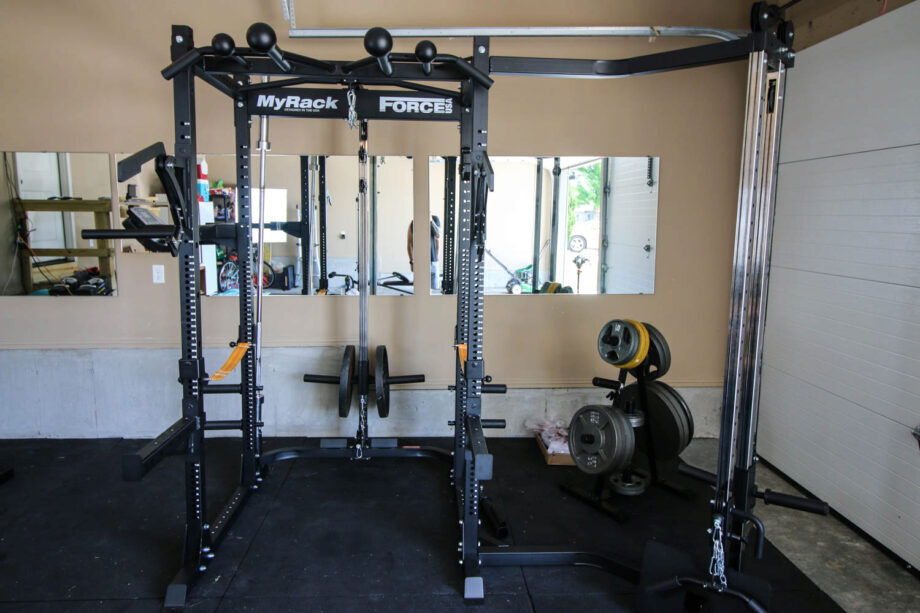Building a strong back in the gym is a worthy endeavor, and not just for the sport-specific benefits including increased strength, size, and endurance in the muscle group.
Performing a back workout with dumbbells over time can provide lumbar support, stability, and relief from nagging neck and back pain. Those muscles include:
- Upper back muscles like the upper traps, levator scapulae, and the rhomboids
- Mid-back muscles like the trapezius and both the teres major and minor
- Lower back muscles like the latissimus dorsi, erector spinae, and other posterior chain
A 2020 study published in Medical Science Monitor1 observed this pain-relieving effect associated with strengthening the back muscles, specifically the lower trapezius. That’s why back strength training is not reserved for just athletes, but can be beneficial for everyone.
There are many ways to build muscle in your back, including barbell exercises, kettlebell training, and even some bodyweight movements; but have you considered trying a back workout with dumbbells? The best dumbbells are endlessly versatile, perfectly suited for beginners, and provide incredible benefits that at times eclipse what you’re able to achieve with even the almighty barbell.
That’s why we’ve compiled a list of some of the best dumbbell back exercises out there. Incorporate some of these bad boys into your next sesh and you’ll be well on your way to a stronger back and an overall healthier lifestyle.
Back Workout With Dumbbells
Here, we will break down the best dumbbell exercises to build muscles in your back.
Move 1: Bent-Over Dumbbell Row
Sets: 3 to 6
Reps: 6 to 12
How to do it:
- Stand with your feet hip-width apart while holding a dumbbell in each hand with an overhand grip. Allow the weights to hang down with your arms fully extended.
- Tilt your chest until it is nearly parallel with the floor, holding your core tight.
- Keeping your lower back straight, row the weights to your sternum.
- Repeat as needed.
RELATED: The Best Bent-Over Row Alternatives

Move 2: Single-Arm Dumbbell Row
Sets: 3 to 6
Reps: 6 to 12
How to do it:
- Hold a dumbbell in one hand and step your opposite foot forward to enter a staggered stance. Place your free hand on a bench for increased stability.
- Lean your chest forward, forming between a 45-degree and 90-degree angle. Allow the arm holding the dumbbell to fully extend and hang.
- Squeeze your shoulder blade and row the weight up into the body.
- Repeat as needed.
RELATED: How To Do One-Arm Dumbbell Rows

Move 3: Dumbbell Shrugs
Sets: 3 to 6
Reps: 6 to 12
How to do it:
- Stand with your feet shoulder-width apart.
- Pick up a dumbbell in each hand using a neutral grip and hold them at your sides.
- Bend your knees slightly.
- With your arms straight, your chin up, and your core tight, bring your shoulders to your ears and squeeze at the top of the movement.
- Slowly return to the starting position. Repeat as needed.

Move 4: Dumbbell Flys
Sets: 3 to 6
Reps: 6 to 12
How to do it:
- Sit at the edge of a bench with a pair of dumbbells on your knees.
- Lie down on your back and bring the dumbbells together above your chest with arms raised.
- Slowly lower your arms to your sides while maintaining a slight bend in the elbow.
- Bring the dumbbells back up, engaging your chest and squeezing your pecs at the top of the movement. Hold briefly before cycling into the next rep.
- Repeat as needed.

Move 5: Dumbbell Lateral Raises
Sets: 3 to 6
Reps: 6 to 12
How to do it:
- Stand with your arms at your sides, elbows slightly bent, and a dumbbell in each hand with your palms facing each other.
- Raise the arms outwards until they reach shoulder height.
- Slowly return to the starting position.
- Repeat as needed.

Move 6: Dumbbell Pullover
Sets: 3 to 6
Reps: 6 to 12
How to do it:
- Lie on a flat bench. Your knees should create a 90-degree angle, your feet planted firmly on the floor, and your upper back and shoulder blades should press into the bench.
- Hold the dumbbell with both hands above your head.
- Keeping a slight bend in the elbows, lower your arms behind your head until your arms are essentially pointed to the wall behind you.
- Push the dumbbell back up into the starting position.
- Repeat as needed.
RELATED: The Best Weight Benches

Move 7: Dumbbell Deadlift
Sets: 2 to 4
Reps: 1 to 5
How to do it:
- Stand with your feet hip-width apart and two dumbbells on the floor in front of you.
- Bend slightly at the knees, bring your hips back, and tilt your chest forward in order to grab the dumbbells with an overhand grip.
- Lift the dumbbells by driving through your heels and standing up straight. Keep the weights close to your body and engage your glutes and hamstrings as you stand.
- Pause briefly at the top of the movement and squeeze your glutes.
- Slowly lower the dumbbells back down to the floor by reversing the movement.
- Repeat as needed.
RELATED: How To Deadlift With Dumbbells

Move 8: Renegade Row
Sets: 3 to 6
Reps: 6 to 12
How to do it:
- Select your dumbbells and place them on the floor. Get into a high plank position, holding the dumbbells instead of placing your palms on the floor. Make sure your wrists are stacked directly under your shoulders.
- Row one dumbbell upward to your chest, engaging your core to maintain stability.
- Slowly return to the starting position and repeat for the other side.
- Repeat as needed.

Putting It All Together: Back Workout With Dumbbells
So, you’ve got yourself a high-quality set of dumbbells and, thanks to this guide, you now know the best exercises to get a great back workout. There’s still something missing.
How do we program these exercises into a comprehensive back workout with dumbbells? How many sets and reps will support us in achieving our fitness goals?
According to a 2015 study published in the Journal of Strength and Conditioning Research2, “[multiple] sets of each exercise were superior to a single set of each exercise in promoting strength, muscle endurance, and muscle hypertrophy increases in upper-body musculature.” Researchers observed optimal effects when participants completed between three and five sets of eight to twelve reps, as this rep scheme “emphasizes both strength and local muscular endurance.”
Another study, published in 2002 in the European Journal of Applied Physiology3, compared results of thirty-two untrained men after undergoing “an 8-week progressive resistance-training program.” Participants were divided into groups performing a low rep scheme, intermediate rep scheme, and high rep scheme.
The study determined that “maximal strength improved significantly more for the Low Rep group compared to the other training groups,” who performed four sets of only three to five reps, while “maximal aerobic power and time to exhaustion significantly increased at the end of the study for only the High Rep group,” who performed two sets of between twenty and twenty-eight reps.
Based on these studies, we recommend choosing three or four of your favorite exercises from our list and completing the number of sets and reps that will support your personal fitness goals.
For strength, go heavy on only a few reps at a time. If you want hypertrophy, an intermediate number of sets and reps may work best. For muscular endurance and improved cardio, a high number of reps at a lighter weight.
When in doubt, consult a qualified fitness professional, coach, or CPT for personalized advice.
RELATED: How Many Reps To Build Muscle
Back Workout With Dumbbells: Final Thoughts
Many fitness enthusiasts feel like they need a heavy barbell to deadlift or specialized equipment like the best lat pulldown machine to get those gains and build that back.
That’s simply not true.
Regularly performing our dumbbell back exercises above will help support improvements in muscle strength, size, and endurance, provided you program a routine that supports your personal fitness goals and you stay consistent. All you need is a great set of dumbbells, and you are golden.
So, what are you waiting for? Grab those weights and let’s get to work!
Back Workout With Dumbbells: FAQ
Can you train your back with dumbbells?
There are many tools for building a strong back, including barbells, kettlebells, machines like the lat pulldown and seated cable row, but, as indicated by our guide, a set of the best dumbbells is more than enough to complete a comprehensive collection of back exercises.
Dumbbells are convenient, versatile, and provide a greater range of motion than your classic barbell, making them invaluable to any back strength training regimen.
How can I train my back at home?
There are many ways to train your back at home. Our list of exercises above provides an excellent place to start, and you should see great results from performing this workout routine regularly provided you prioritize proper form and employ progressive overloading.
Supplementing your back workout with other exercises, like pull-ups, and compound lifts, like back squats, will also be beneficial while following this training program.
RELATED: Best Back Exercises
How do you build a wide back with dumbbells?
Building a wide back is all about targeting muscles all across your back. Dumbbell exercises like the dumbbell bent-over row, reverse fly, and pullover are all critical, while tried-and-true lifts like the deadlift and, alternatively, the Romanian deadlift work well too.
Beyond dumbbells, we’d never disparage the benefits of an expertly-executed pull-up. Both wide grip and close grip pull-ups will assist in building a wide back.
RELATED: What Muscles Do Pull-Ups Work?
What do shrugs work?
Shrugs involve your shoulders, but you’ll also get great activation in back muscles like the trapezius, levator scapulae, and rhomboids.
You’ll experience similar activation in the same muscle groups performing the upright row, making these two exercises important if you’re looking to inspire muscle growth and strength gains in this region.
How do you work out your back with one dumbbell?
One of the best things about dumbbells is that you really only need one to get the job done.
Most back exercises that use dumbbells are unilateral movements or can be performed unilaterally if you either want to give a full effort to each side individually, need to correct imbalances, or simply don’t have a second dumbbell on hand.
While our list already includes the single-arm dumbbell row, nearly all of our picks can be converted into a unilateral movement. Simply perform the exercise with the dumbbell in your right hand, then pass it to your left hand and repeat the set.
It’s worth noting, however, that holding only one dumbbell will pose a new challenge to your balance and stability. Start out with lighter weights to practice proper form for a unilateral dumbbell exercise before really going heavy.
And, as always, consult a personal trainer if you need any help.
References
1. Park SH, Lee MM. Effects of Lower Trapezius Strengthening Exercises on Pain, Dysfunction, Posture Alignment, Muscle Thickness and Contraction Rate in Patients with Neck Pain; Randomized Controlled Trial. Med Sci Monit. 2020;26:e920208. Published 2020 Mar 23. doi:10.12659/MSM.920208
2. Radaelli R, Fleck SJ, Leite T, et al. Dose-response of 1, 3, and 5 sets of resistance exercise on strength, local muscular endurance, and hypertrophy. J Strength Cond Res. 2015;29(5):1349-1358. doi:10.1519/JSC.0000000000000758
3. Campos GE, Luecke TJ, Wendeln HK, et al. Muscular adaptations in response to three different resistance-training regimens: specificity of repetition maximum training zones. Eur J Appl Physiol. 2002;88(1-2):50-60. doi:10.1007/s00421-002-0681-6







